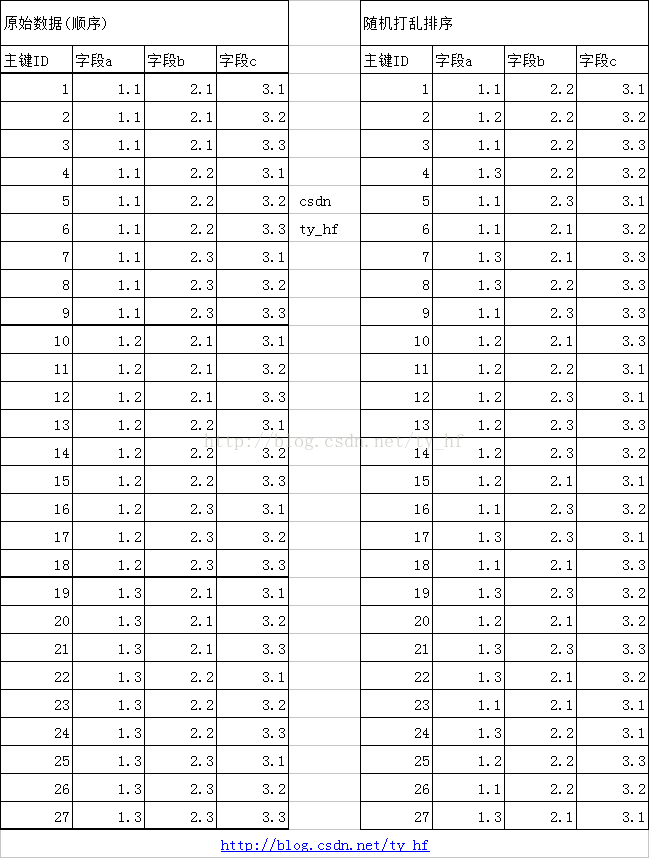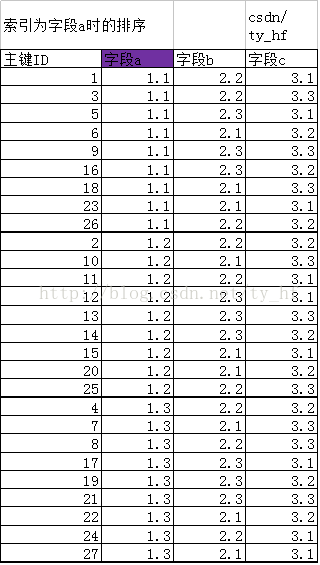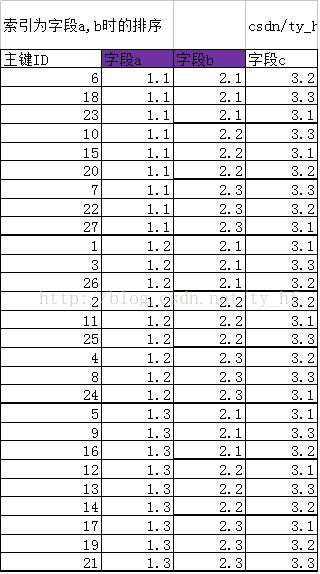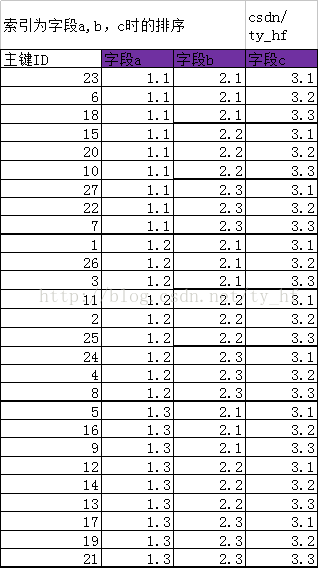Mysql-index data sorting
The previous article briefly introduced several structures and storage methods of B-TREE, but the relationship between index and data still does not seem to be related.
So this article will use the actual An example of data rows. After creating the index, what is the order in which they are sorted on B+TREE.
1. Simulate and create original data
In the figure below, the left side is the simulated data for my own convenience. The engine is mysiam~
The right side is a normal simulation data table after randomly arranging them using EXCEL. The primary keys are then arranged according to 1-27 (if it is not random, I will write it in order when simulating the data. Adding an index makes it difficult to see the index sorting process)
That is to say, the data on the right, so that the original data we want to test, was sorted like this before the index was built, and all subsequent data are sorted by This is done according to the standards, so that you can better see the sorting effect after the index is generated.
The table has 4 fields (id, a, b, c), with a total of 27 rows of data

2. Create index a
As shown below, after creating index a, in the index structure, the original ordering according to the primary key ID becomes a new rule. We say that the index is actually a data structure. Then create index a, which is to create a new structure, sort according to the rules of field a, the first data row represented by the primary key ID is 1, the second data row represented by ID=3, and the third data row represented by ID=5 data row. . .

New sorting primary key ID (ID represents their row of data): 1 3 5 6 9 16 18 23 26 2 10 11 12 13 14 15 20 25 4 7 8 17 19 21 22 24 27
It is not difficult to find that when field a is the same, their arrangement is based on the primary key ID before and after, for example, the same value is a=1.1, But their ordering is ID value 1, 3, 5, 6. . The corresponding rows are sorted in a similar order to the primary key ID. (That is, the sorting when the same value is used, the smaller ID is in front)
3. Create index (a,b)
As shown below, when creating a union After indexing (a,b), in the index structure, the original sorting according to the primary key ID has changed to a new rule. The sorting rule first sorts according to field a, and then sorts according to field b based on a. That is, based on index a, field b is also sorted.

New sorting primary key ID (ID represents their row of data): 6 18 23 10 15 20 7 22 27 1 3 26 2 11 25 4 8 24 5 9 16 12 13 14 17 19 21
It is not difficult to find that when the values of fields a and b are the same, their arrangement is also determined by the primary key ID Determined, for example, the same row (18,6,23) with a=1.1 and b=2.1, but their order is 6,18,23.
Field (a,b) index, first sort by a index, and then based on a, sort by b
6 18 23 10 15 20 7 22 27 1 3 26 2 11 25 4 8 24 5 9 16 12 13 14 17 19 21
4. Create index (a,b,c)
field(a,b ,c) Index, first sort by a, b index, then based on (a, b), sort by c

New sorting primary key ID (represented by ID Data for their line): 23 6 18 15 20 10 27 22 7 1 26 3 11 2 25 24 4 8 5 16 9 12 14 13 17 19 21
5. Conclusion:


is the same as the previous article Mysql-Index-BTree Type [Simplified], B-TREE tree The last row of leaf nodes, arranged from left to right, is in this order. Different indexes are in different orders. With the order, wouldn't the search be much more convenient and faster?
#We know that the process of reading data (equivalent to the process of finding a room), if there is Index (room registration table), first read the data structure of the index (because it has small data and is fast to read), find the storage location of the real physical disk in the leaf node of its structure (equivalent to finding the house number), and then get Go to the disk with the house number and get the data directly. This is a process of reading data. If there is no index, it means you don’t know the destination. Just search from room to room.
When there is no index, the primary key ID is actually their index, arranged according to the rules of primary key ID from small to large;
When there is an index, index a, joint index (a, b ), the joint index (a, b, c) corresponds to the three B+TREE structures, and the physical disks pointed to by the end of the leaf nodes are different.
Conclusion:
1. If no index is created, it is arranged in ascending order according to the ID primary key
2. When index a is created, A new structural index (B+TREE) will be generated to record a new structural rule to facilitate quick search
3. When creating index a, index ab, index abc, the three corresponding data are sorted It’s different
4. Index abc takes into account both index ab and index a, so when the former is available, the latter two do not need to be created
5. When an index is created, non-indexed columns are sorted by increasing ID by default
More conclusions: Mysql-index summary: http:// blog.csdn.net/ty_hf/article/details/53526405
When a new piece of data is inserted, while storing the data, a copy of this table will also be maintained. Index and place it in a suitable location. It explains why indexes may have negative effects when the amount of data is particularly large. INSERT and DELETE on the indexed table will become slower. Frequent insertion and deletion of data will also consume time in maintaining the index. What is the bottleneck? ? 500W? To be verified.
The above is the content of Mysql-index data sorting. For more related content, please pay attention to the PHP Chinese website (www.php.cn)!

Hot AI Tools

Undresser.AI Undress
AI-powered app for creating realistic nude photos

AI Clothes Remover
Online AI tool for removing clothes from photos.

Undress AI Tool
Undress images for free

Clothoff.io
AI clothes remover

Video Face Swap
Swap faces in any video effortlessly with our completely free AI face swap tool!

Hot Article

Hot Tools

Notepad++7.3.1
Easy-to-use and free code editor

SublimeText3 Chinese version
Chinese version, very easy to use

Zend Studio 13.0.1
Powerful PHP integrated development environment

Dreamweaver CS6
Visual web development tools

SublimeText3 Mac version
God-level code editing software (SublimeText3)

Hot Topics
 MySQL's Role: Databases in Web Applications
Apr 17, 2025 am 12:23 AM
MySQL's Role: Databases in Web Applications
Apr 17, 2025 am 12:23 AM
The main role of MySQL in web applications is to store and manage data. 1.MySQL efficiently processes user information, product catalogs, transaction records and other data. 2. Through SQL query, developers can extract information from the database to generate dynamic content. 3.MySQL works based on the client-server model to ensure acceptable query speed.
 Laravel Introduction Example
Apr 18, 2025 pm 12:45 PM
Laravel Introduction Example
Apr 18, 2025 pm 12:45 PM
Laravel is a PHP framework for easy building of web applications. It provides a range of powerful features including: Installation: Install the Laravel CLI globally with Composer and create applications in the project directory. Routing: Define the relationship between the URL and the handler in routes/web.php. View: Create a view in resources/views to render the application's interface. Database Integration: Provides out-of-the-box integration with databases such as MySQL and uses migration to create and modify tables. Model and Controller: The model represents the database entity and the controller processes HTTP requests.
 How to start mysql by docker
Apr 15, 2025 pm 12:09 PM
How to start mysql by docker
Apr 15, 2025 pm 12:09 PM
The process of starting MySQL in Docker consists of the following steps: Pull the MySQL image to create and start the container, set the root user password, and map the port verification connection Create the database and the user grants all permissions to the database
 Solve database connection problem: a practical case of using minii/db library
Apr 18, 2025 am 07:09 AM
Solve database connection problem: a practical case of using minii/db library
Apr 18, 2025 am 07:09 AM
I encountered a tricky problem when developing a small application: the need to quickly integrate a lightweight database operation library. After trying multiple libraries, I found that they either have too much functionality or are not very compatible. Eventually, I found minii/db, a simplified version based on Yii2 that solved my problem perfectly.
 How to install mysql in centos7
Apr 14, 2025 pm 08:30 PM
How to install mysql in centos7
Apr 14, 2025 pm 08:30 PM
The key to installing MySQL elegantly is to add the official MySQL repository. The specific steps are as follows: Download the MySQL official GPG key to prevent phishing attacks. Add MySQL repository file: rpm -Uvh https://dev.mysql.com/get/mysql80-community-release-el7-3.noarch.rpm Update yum repository cache: yum update installation MySQL: yum install mysql-server startup MySQL service: systemctl start mysqld set up booting
 Centos install mysql
Apr 14, 2025 pm 08:09 PM
Centos install mysql
Apr 14, 2025 pm 08:09 PM
Installing MySQL on CentOS involves the following steps: Adding the appropriate MySQL yum source. Execute the yum install mysql-server command to install the MySQL server. Use the mysql_secure_installation command to make security settings, such as setting the root user password. Customize the MySQL configuration file as needed. Tune MySQL parameters and optimize databases for performance.
 Laravel framework installation method
Apr 18, 2025 pm 12:54 PM
Laravel framework installation method
Apr 18, 2025 pm 12:54 PM
Article summary: This article provides detailed step-by-step instructions to guide readers on how to easily install the Laravel framework. Laravel is a powerful PHP framework that speeds up the development process of web applications. This tutorial covers the installation process from system requirements to configuring databases and setting up routing. By following these steps, readers can quickly and efficiently lay a solid foundation for their Laravel project.
 MySQL and phpMyAdmin: Core Features and Functions
Apr 22, 2025 am 12:12 AM
MySQL and phpMyAdmin: Core Features and Functions
Apr 22, 2025 am 12:12 AM
MySQL and phpMyAdmin are powerful database management tools. 1) MySQL is used to create databases and tables, and to execute DML and SQL queries. 2) phpMyAdmin provides an intuitive interface for database management, table structure management, data operations and user permission management.






